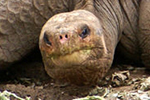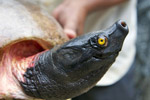Sometimes turtles fall through the cracks: a new study in the open access journal Tropical Conservation Science, has uncovered a number of ‘gap species’ in the turtle families inhabiting Africa. ‘Gap species’ are those that are recorded in one country or another, but not in adjacent countries which could be due to a lack of data, a change in ecosystems, or human impacts.
“It is important to have detailed accounts of species occurrences by country, as these data are basic for many conservation actions,” the researchers write.
In the case of turtles, insufficient surveying and a lack of resources may mean a species is present in a country where it has currently not been recorded. But there could be other reasons behind ‘gap species’: the species may be naturally absent due to ecosystem changes or human overexploitation, leading to local extinction. But, conservationists cannot know for sure until researchers take a hard look at why turtles are present in some countries and not others.
“Gap species were primarily found among the moist savannah and tropical forest dwellers,” the researchers write. “We consider this to be a direct consequence of heavy rates of habitat loss and fragmentation of moist savannahs (for instance, the Guinea savannah in West Africa) and tropical forests, thus isolating populations of [turtles] which were once spread widely throughout these habitat types.”
The researchers also found that the majority of gap turtles were large-bodied, likely pointing to the toll the bushmeat trade is taken on bigger turtles.
Interestingly many of the gap turtles mirrored similar gap species among small mammals, a trend that the researchers linked to the loss of rainforests on the continent.
“Tropical forest fragmentation is causing the extirpation of many populations of both chelonians and small mammals, and thus conservation efforts at the continental scale should be devised especially to preserve the remaining tropical forests,” they write.
The study also concludes that gap turtles in some countries, such as Congo, the Central African Republic, and Cameroon is likely due to a lack of research.
CITATION: Luiselli,L., Civetta, F., Masciola , S., Milana, G., and Amori, G. 2012. Spatial turnover and knowledge gaps for African chelonians mirror those of African small mammals: conservation implications. Tropical Conservation Science Vol. 5(3):365-380.
Related articles
Lonesome George passes, taking unique subspecies with him

(06/25/2012) Lonesome George, the sole surviving member of the Pinta Island tortoise (Chelonoidis nigra abingdoni), was found dead on Sunday by staff at the Galapagos National Park. With George’s passing, the Pinta Island tortoise subspecies officially falls into extinction. First found in 1972, Lonesome George became famous for representing the last of his kind. He was believed to be around 100—middle-aged for a Galapagos tortoise which can live to 200 years old. Staff plan to do an autopsy to determine the cause of death.
Conservationists successfully hatch world’s fourth most endangered turtle
(06/11/2012) The world’s fourth most endangered turtle has received a happy boost from breeding efforts, reports the AFP. Bangladeshi scientists have successfully hatched 25 northern river terrapins (Batagur baska) using an artificial beach constructed in the country’s Bhawal National Park.
Hail Mary effort aims to save the world’s most endangered turtles

(04/17/2012) The Wildlife Conservation Society (WCS) has pledged to work with all of its institutions to save at least half of the world’s most 25 endangered turtles as listed in a report by WCS and the Turtle Conservation Coalition last year. The program will include both conservation work in the field as well as participation from WCS’s zoological institutions for captive breeding and future reintroductions. Even with WCS’s ambitious program, however, it is likely this century will see a number of turtle extinctions.
Featured video: the world’s greatest turtle collection
(04/16/2012) At a seemingly small residence in Florida, lives the world’s greatest turtle collection. The Chelonian Research Institute contains a specimen of nearly every species of turtle found worldwide and many live species. Founded and headed by Dr. Peter Pritchard, the institute is both a research center and an active museum.







